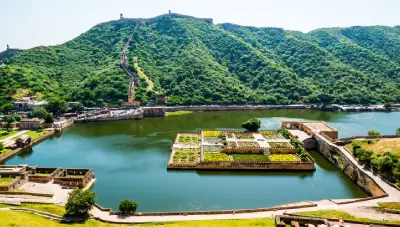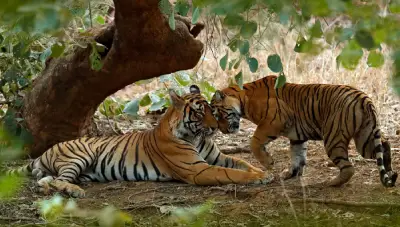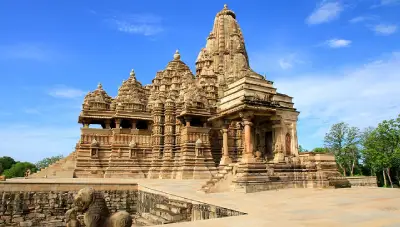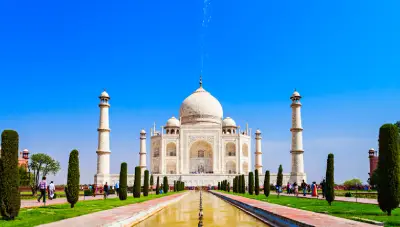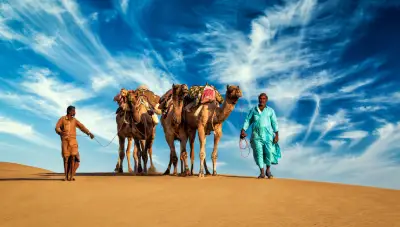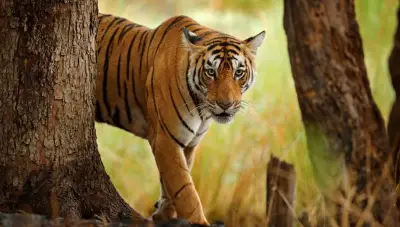Jaisalmer's vibrant city has an even vibrant history to boast. The city of Jaisalmer was established by the Bhati Rajput ruler, Raja Rawal Jaisal in 1156 after he moved from Lodhruva to Jaisalmer in search of a safer capital. Jaisalmer became an important site for traders since it connected the regions of Egypt, Africa, Persia, and India and provided for a trading route through the desert.
Understanding its geographical importance, Jaisalmer levied taxes on the camel caravans which passed through the capital and was a prominent source of income for the kingdom. But later, as the sea trade flourished, and the border of India and Pakistan were closed up, the city's tax revenue from being a trading route declined.
A witness to a number of wars and battles, Jaisalmer finally signed a treaty in 1818 with the British to safeguard itself from enemy forces. It was after Independence that the princely state of Jaisalmer was integrated into the Union of India and became part of the state of Rajasthan.
Quick information about Jaisalmer
| State |
Rajasthan |
| Coordinates |
26.9157° N, 70.9083° E |
| Geographical area |
38,401 square kilometers |
| Popular Tourist Attractions in Jaisalmer |
Golden Fort and its palaces, Patwon ki Haveli, Nathmal ji ki Haveli, Salim Singh ji ki Haveli, Mandir Palace, Lakshminath Temple, Ramdevra Temple, Tanot Mata Temple, Gadsisar Lake, Desert Cultural Center and Museum, Sam Sand Dunes |
| Popular Festivals of Jaisalmer |
Jaisalmer Desert Festival, Gangaur Festival, Ramdevra Fair |
| Languages Spoken |
Rajasthani, Hindi, English |
Tourism in Jaisalmer
The 'Queen of Thar,' Jaisalmer is inarguably the best travel destination in Rajasthan. Believed to offer tourists an unparalleled holiday experience, the city is the gateway to the culturally and historically abundant Rajasthan. Jaisalmer is also referred to as the 'Golden City', due to its beautiful structures made of yellow sandstone.
It is in Jaisalmer that one is able to witness the perfect blend of nature, architecture, hospitality and adventure. This prized tourist destination is all about providing an unmatched experience to witness Rajasthan's warm hospitality while relishing in its art and architecture.
Jaisalmer also offers various enthralling adventure activities and memorable camel safaris in its desert. Jaisalmer is a popular destination in Rajasthan and a tourism haven with its massive forts, fascinating havelis and hot desert, but it is also about the coexistence of these attractions in perfect harmony.
Forts and Havelis- of the Golden City
The major tourist attraction of the city is its stunning Golden Fort. Located in the Thar Desert, on the Trikuta Hills, the Golden Fort was made by Raja Rawal Jaisal in 1156 AD and is a UNESCO World Heritage Site under the Hill forts of Rajasthan.
The fort is called so due to the structure being entirely made of yellow sandstone. The fort houses many palaces, shops, temples, and places where hundreds of people still live today and hence is also known for being one of the few living forts in the world.
The sunsets at the fort are particularly breathtaking when the sun shines on the sandstone structure and makes the whole place shine. There are architectural masterpieces in Jaisalmer in the form of ancient havelis like the Raja ka Mahal, Rani ka Mahal, Patwon ki Haveli, Nathmal ji ki Haveli, Salim Singh ji ki Haveli, and the Mandir Palace.
Raja ka Mahal Palace is the main palace of the Golden fort and is the palace where the then kings of the kingdom resided. The palace is intricately designed all over and is an architectural marvel. The various balconies, courtyards, jharokhas, and chambers add to the beauty of the structure.
As you enter the palace, you will notice orange colored hand prints. These belonged to the women of the palace who committed Jauhar at the Dussehra Chowk in the fort. Jauhar was a ritual, practiced primarily by the Rajput women where they self-immolated at a central spot in case of an assured loss against the enemy.
Death by Jauhar was done to avoid being captured by the enemy forces and was considered an honorable way to die.
Close by to the Raja ka Mahal Palace is located the Rani ka Mahal Palace. As the name suggests, the palace was the place of residence for the royal women of the kingdom.
The extravagant Patwon ki Haveli is a cluster of 5 Havelis situated at Jaisalmer. Built in 1805 by Guman Chand Patwa, the palace is also called the Mansion of Brocade Merchants and is the largest haveli in Jaisalmer.
What attracts tourists to this place is its architecture, with its fascinating mirror work, intricate carvings and paintings; it's a sight to behold. There is even a museum at the Haveli that you can explore.
It gives a glimpse into the lives of the people who once lived in the haveli. The gorgeous balconies and the colorful murals on the walls, you are bound to love the place.
Located in the Sadar Bazaar of Jaisalmer, the Nathmal Ji ki Haveli is another top tourist attraction of the city. It is another one of the beautifully carved sandstone structures the city prides itself in and served as the residence of the Prime Minister of the kingdom of Jaisalmer at the time, Diwan Mohta Nathmal Ji.
The palace is decorated with miniature paintings from within along with paintings made of gold-leaf and intricate wall carvings. There are various stories about how the palace came about to be, with each more interesting than the previous.
A popular one is that the palace was built by 2 brothers who started constructing the place from each end. A lack of communication between them gave the palace a distinct look with each end of the palace looking different from the other. How different do they really look? If you're curious you might want to find out for yourself.
The Salim Singh Ji ki Haveli is another one of the popular spots to visit on your trip to the city of Jaisalmer. It is said to be built in 1815 by the then Prime Minister of Jaisalmer, Salim Singh Ji. The beautiful palace is also called Jahaz Mahal, given its resemblance to a ship's stern.
The Palace adorns 38 intricately carved balconies along with the roof made to look like a peacock. The Moti Mahal inside the palace is a place you must visit. The beautiful palace was once the place where aristocrats and the royals of the kingdom gathered to enjoy the royal dances.
Another gem in Jaisalmer tourism is the Mandir Palace. Built as a residence for Maharaja Moolraj, the palace is a cluster of structures and houses beautiful structures within. One such structure is the Badal Vilas. It is a tall structure that includes the Tazia Tower. The tower was made by a muslim craftsmen and is called so since it is shaped like a Tazia.
The tower is 5 storeys tall and offers a panoramic view of the entire city. The Mandir Palace was made by Maharaja Moolraj due to his desire of living in a place with lots of temples. Even though the palace was built by him, other structures have been added over the years by his descendants.
Today, the palace stands as a heritage hotel and hence a number of architectural changes have been made over time, yet the essence remains unchanged.
Jaisalmer- Legendary Temples
As mesmerizing as its palaces and forts are Jaisalmer's Temples. A site for worship and divinity, the temples are not just healing for the soul but also for the eyes with their beautiful craftsmanship. Not just that, what makes them even better are the legendary stories that are attached. Don't miss out on these on your trip to Jaisalmer.
The Golden Fort of Jaisalmer is a living fort which at one point housed the entire kingdom of Jaisalmer within its walls and so prominent temples are found here. There are 7 beautiful Jain Temples that can be found within the fort, each dedicated to a different Tirthankara, or Jain spiritual teachers, namely the Chandraprabhu Jain Temple, Rishabhdev Jain Temple, Parsvanath Jain Temple, Sheetalnath Jain Temple, Kunthunath Jain Temple, and the Sambhavnath Jain Temple.
These temples were made by rich Jain traders who resided in Jaisalmer and display intricate work of sandstone. The most popular among these is the Parsvanath Jain Temple, and is believed to be the most impressive among these.
Dedicated to the Hindu Goddess Lakshmi and the Hindu God Vishnu, the Lakshminath Temple at Jaisalmer is another popular tourist attraction. Built in 1494 by Rao Lunkaran, it is another temple within the walls of the Jaisalmer Fort. A serene place to be, the temple's walls and ceilings are adorned with images of Gods and Goddesses from Hindu mythology.
The Ramdevra Temple at Jaisalmer is a temple sacred to the folk people of the city and is dedicated to the folk deity of Baba Ramdevji. The temple holds prominence among Hindus and Muslims alike.
Hindus believe the Baba to be the reincarnation of Lord Krishna and hold him in reverence whereas the Muslims honor him as Ramshah Pir, and know him to be with magical and spiritual powers. The temple is said to be the resting place of Baba Ramdevji when he took samadhi in 1459. It was later in the early 1900s that a temple was built around the samadhi by Maharaja Ganga Singh of Bikaner.
Another place that you must explore on your stay in Jaisalmer is the Tanot Mata Temple. This temple is currently preserved and maintained by the Border Security Force due to its significance in the Indo-Pak war of 1965 and 1971.
The temple, built by the Bhati Rajput King Tanu Rao in 847 AD was made to honor Tanot Mata, an incarnation of Hinglaj Mata. According to the legend revolving around the temple, Pakistan's army threw around 3,000 bombs onto India's side in 1965 to enjoy a sweeping victory, but to their dismay none of the bombs exploded when they landed near the temple. Later, in the Indo-Pak war of 1971, Pakistan Army's squadron of 45 tanks was defeated against 120 soldiers of the Indian Army.
Since the event took place at Longewala, where the temple resides, it is said to have protected the army from defeat. After 1971, the BSF took over the maintenance of the temple and even erected a Vijaya Stambha to mark its victory at Longewala. The unexploded bombs are also preserved in the museum within the temple's premises.
Other Popular Points of Interest in Jaisalmer
Jaisalmer's Gadsisar Lake is a man-made lake originally built by Raja Rawal Jaisal as a water reservoir to provide water in the dry land of Jaisalmer and was the sole supplier of water to the kingdom. It was later when the lake was reconstructed by Maharaja Gadsi Singh that the lake was renamed and called the Gadsisar Lake.
The Tilon-ki-Pol is a popular tourist attraction of the lake. Built in yellow sandstone it is a multi-storeyed arched gateway that lets you to the lake. At the banks of the lake you can even find a temple dedicated to Lord Shiva. The lake is the perfect spot to get some instagram worthy pictures and to take a nice evening stroll.
You can also enjoy boating on the lake and feed the fish in it. If you go towards the evening you can even watch the beautiful light and sound show depicting the history and evolution of Jaisalmer. It is a sight you will not forget.
To understand the culture and history of the people of Jaisalmer even better, you might want to visit the Desert Cultural Center and Museum. The Museum was established in 1997 and displays Jaisalmer's desert culture, art and crafts.
It contains ancient artifacts such as old coins, textiles, sculptures, jewelry, handicrafts, weapons, and musical instruments. The museum displays objects that were used by the common people of the desert and helps to imagine their daily lives. The place is maintained by Jaisalmer's Tourism Department and also organizes a puppet show for the visitors.
Being in the Thar Desert, you cannot leave Jaisalmer without exploring its desert. The Desert Safari is a very popular tourist attraction of the city and is bound to give you an experience you will cherish forever. The arid and expansive Sam Sand Dunes is a hub of some thrilling experiences.
Stay in the middle of the desert in a cozy tent and enjoy the cultural way of Jaisalmeri living with folk performances and delightful cuisine, or cruise through the desert on a camel. If you love adventure, you can also try out parasailing or paramotoring on your stay. The desert safari at Jaisalmer is as colorful as the city and is something you must experience on your visit to the city.
Handicrafts of Jaisalmer- Shopaholics' Galore
The city is a must-visit for the shopaholics who have a special taste in handicraft and earthly goods and articles. It is the best place to shop for souvenirs of all types to take back as a memoir.
The Golden city of Jaisalmer takes pride in its traditional handicrafts and displays the city's beautiful colors through them. Jaisalmer is popular for its leather articles of handbags, satchels, and mojaris, which are hand stitched and intricately embroidered to give them that Jaisalmeri touch.
Also popular are the kurtas, sarees, and dupattas made in tie and dye Bandhej style and the traditional Batik print. The hand woven carpets of Jaisalmer are also quite popular for their use of pure wool and traditional motif designs.
Celebrations at Jaisalmer- Live the Culture
It is during celebrations that a place comes truly alive and the celebrations at Jaisalmer are as vibrant as its people. The festivals that primarily happen at Jaisalmer include the Jaisalmer Desert Festival, Gangaur Festival and the Ramdevra Fair.
The Jaisalmer Desert Festival is a 3 day festival that is organized by the Rajasthan Tourism Department during the month of February and is held at the Sam Sand Dunes. The festival is a cultural celebration with various folk and cultural performances, and dances such as Ghoomar and Kalbelia taking place. There is even a camel race that happens and is one of the highlights of the festival. The festival also organizes a puppet show and a turban-tying competition to entertain the visitors, along with the enchanting Fire and the Gair dance.
The Gangaur festival is a harvest festival that is celebrated by the women of Jaisalmer and honors Goddess Gauri, Lord Shiva's consort. Celebrated in the season of spring, the festival is an 18 day affair with the women praying to the Goddess for a prosperous marriage.
Held at the Ramdevra Temple, the Ramdevra Fair happens during the months of August and September and honors Baba Ramdevji with the devotees singing Bhajan and Kirtans to remember him.
Best Time to Visit Jaisalmer
The best time to visit Jaisalmer is between the months of October and March when the weather is colder and pleasant. It is the peak season for tourism in the city since the weather makes it pleasant to travel.
Being close to the Thar Desert, Jaisalmer can get extremely hot in the months of April to June with temperatures reaching up to a scorching 46 degrees celsius, and is not ideal for travel. It is therefore best to avoid the summer months.
The city experiences monsoon from July to September. There might be fewer crowds as compared to other months but the weather can get pretty humid and uncomfortable.
For planning a Jaisalmer Tour, it is important to have an authentic travel guide, which Tour My India ensures to provide. We let you experience the best holiday with the best combination of comfortable stay and sightseeing tour around the city at your chosen budget.

 +91-9212777225
+91-9212777225 Plan Your trip
Plan Your trip





